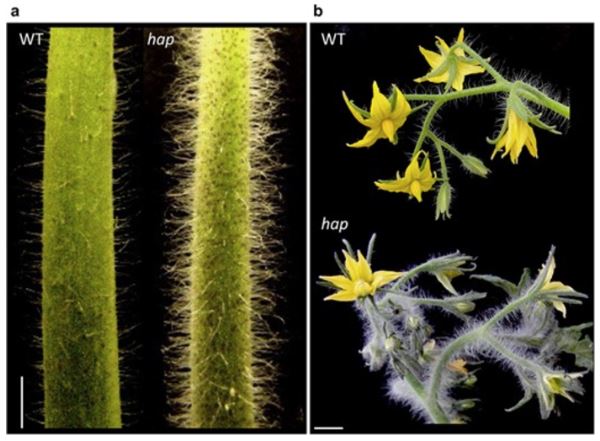China
April 24, 2022

(a) Main vegetative stem of a wild-type (WT) Moneymaker plant and a hap mutant plant with increased trichome density. (b) Inflorescence stem of a WT plant and a hap mutant plant where higher trichome density can be appreciated. Scale bars apply to 1 cm.
Five types of trichomes have been described in cultivated tomato (Solanum lycopersicum L.): type-I is 2–3 mm long with a multicellular base and a glandular small cell in the tip; type-III is non-glandular and 0.4–1 mm long with a unicellular flat base; type-V also has a unicellular flat base and is 0.2–0.4 mm long; type-VI is short with two stalk cells and a glandular head composed of four secretory cells; and type-VII is a very small trichome (0.05 mm) with a glandular head formed from 4 to 8 cells. By contrast, wild tomato species develop type-II and type-IV trichomes, and the latter is characterized by a unicellular flat base and a short stalk that connects to a glandular head. The presence of type-IV trichomes has been described as a heterochronic trait in cultivated tomato species, as these trichomes can only be detected at early developmental stages. Non-glandular trichomes act as a mechanical barrier that hinders pest movement on the plant, whereas glandular trichomes produce specialized metabolites that are toxic or deterrent to the pests or entrap them. Despite the importance of trichomes in pest resistance, very few trichome mutants that shed light on the genetic regulation of multicellular trichome initiation have been described in tomato.
Recently, scientists from Universidad de Almería described and characterized the hairplus (hap) tomato mutant that exhibits a high type-I trichome density. Fine mapping and genetic complementation analysis showed that HAP encodes an SUVH3 histone lysine methyltransferase. This protein family is mainly composed of histone tail–modifying proteins, although some of its members bind methylated DNA, and all play key roles in the epigenetic control of gene expression. Identification of this novel tomato regulator of trichome formation sheds light on the role of SUVH3 histone methyltransferases in transcriptional control mediated by epigenomic modifications.
“Future works should focus on demonstrating that the reduced feeding damage is correlated with pest resistance of hap mutant plants and whether it is related to a higher amount of exudates or to the physical barriers that the trichomes represent in mutant plants,” Prof. Capel said. These findings demonstrate that HAP links epigenome remodeling to multicellular glandular trichome development and reveal that HAP is a valuable genomic tool for improving pest resistance in tomato breeding.
Reference
Functional characterization of the tomato HAIRPLUS gene reveals the implication of the epigenome in the control of glandular trichome formation
Horticulture Research
DOI: 10.1093/hr/uhab015
Publication date: 28-Jan-2022
Authors
Rocío Fonseca1,†, Carmen Capel1,†, Fernando J. Yuste-Lisbona1, Jorge L. Quispe1, Cristina Gómez-Martín2,3, Ricardo Lebrón2,3, Michael Hackenberg2,3,José L. Oliver2,3, Trinidad Angosto1, Rafael Lozano1 and Juan Capel1,*
Affiliations
1 Centro de Investigación en Agrosistemas Intensivos Mediterráneos y Biotecnología Agroalimentaria (CIAIMBITAL), Universidad de Almería, Carretera de Sacramento s/n, 04120 Almería, Spain
2 Department of Genetics, Faculty of Science, University of Granada, Campus de Fuentenueva s/n, 18071 Granada, Spain
3 Laboratory of Bioinformatics, Centro de Investigación Biomédica, PTS, Avda. del Conocimiento s/n,18100 Granada, Spain
About Dr. Juan Capel
Prof. Juan Capel works at Universidad de Almería and has published 78 papers to date.